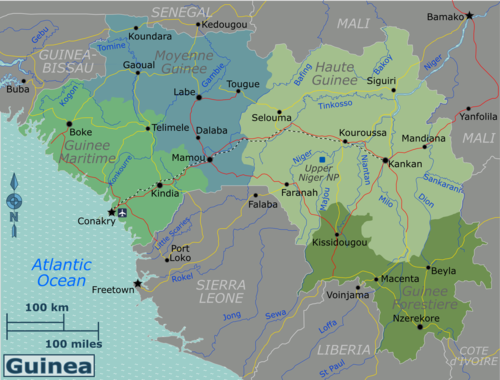- For other entries with the same name, please seeGuinea (disambiguation)。
GuineaIs a country located in West Africa, connected to the southeastCote d'Ivoire, NanlinLiberia, West andSierra Leone, North neighborGuinea-Bissau、Senegal, North and Northeast andMaliborder. The Niger, Senegal, and Gambia rivers originate in Guinea. Guinea originally refers to the entire area south of Africa's Sub-Saharan Desert and north of the Gulf of Guinea. It comes from Berber and means roughly "a country of blacks." capitalConakry。
learn
Brief history
France began to colonize Guinea in 1850, but it encountered stubborn resistance especially in the interior. The original origin of Guinea today is a colony established by France in 1890. Conakry, the capital, was also founded in 1890. In 1958, Guinea passed a referendum on its independence from France.
geography
GuineaLocated in West Africa, to the northGuinea Bissau、SenegalwithMali, EastIvory coast, South AccessLion RockwithLiberia, West EndAtlanticThe coastline is 352 kilometers long and covers an area of about 246,000 square kilometers. The terrain is complex, and the whole territory is divided into 4 natural areas:
The west (called Lower Guinea or Coastal Guinea) covers an area of 36,133 square kilometers and is a long and narrow coastal plain. The whole area is swampy, the temperature is hot and humid, the rainy season is 6-8 months of the year, and the annual precipitation can reach 5000 mm. It is the main economic crop area. A large area of silted wetland in this area is a mangrove area.
The central part (Central Guinea) is the Futa Djallon Plateau with an average elevation of 900 meters. The three main rivers of West Africa-the Niger, the Senegal and the Gambia, all originate here and are called the "West Africa Water Tower".
The northeast (Upper Guinea) covers an area of 97,000 square kilometers and is a platform with an average elevation of about 300 meters. The terrain of the whole area is flat, with a lot of arbor forests. The gold of the Bulle region is world-famous. The main economic activity is animal husbandry.
The southeast (called Forest Guinea) is the Guinea Plateau with an area of 49,374 square kilometers and an average elevation of 500-600 meters. There are large tracts of tropical virgin forest, and Mount Nimba with an elevation of 1,752 meters is the highest peak in the whole country.
The coastal areas of Guinea have a tropical monsoon climate, and the inland has a tropical grassland climate. The annual precipitation is 1,000 to 1,500 mm inland and 4,000 mm along the coast.
area

| Lower Guinea(Guinee Maritime)(Conakry) The coastal area of Guinea, the cultural hometown and capital of the Susu people |
| Central Guinea(Moyenne Guinee)(Daraba) is also calledFouta Djallon, Mainly inland hills and mountains, the climate is relatively cool, it is the home of the people of Pula (Peuls) |
| Upper Guinea(Haute Guinee)(Kankan、Upper Niger National Park) Most of the Yasahel region isMaliIt borders and is divided into two by the Niger River and is the homeland of the Malinques. |
| Southeast Guinea(Guinee Forestiere)(Bella、Nimba Mountain Strict Nature Reserve) Also known as "Forest Guinea". Bordering Liberia and Côte d’Ivoire, it is home to minorities such as Toma and Kissi. The locals retain many ancient traditional customs and cultural beliefs. |
city
- Conakry -The capital of the country
Other destinations
arrival
Aviation 
Railroad 
Private car
Bus 
Passenger ship 
Travel around
Language
go sightseeing
Activity
Shopping
Overhead
diet
Nightlife
stay
Learn
Work
Safety
Guinea is a rather insecure country because it has a history of becoming one of the most unstable countries in Africa; illegal and criminal activities are widespread. Most crimes are committed by officers wearing military uniforms and are usually directed against foreigners. Most non-violent crimes involve pickpocketing and purse snatching, and armed robbery, robbery and assault are the most common violent crimes. Criminals particularly target tourists near airports, traditional markets, and hotels and restaurants frequented by foreigners. Stay vigilant and use common sense when encountering difficulties.
Tourists should also avoid proactively offering help at airports and hotels, as such proposals often obscure the intention of stealing luggage, wallets or wallets. Passengers should arrange for hotel personnel, family members or business contacts to meet with them at the airport to reduce their vulnerability to these opportunities for crime.
When taking photos, avoid military bases and political buildings, because in Guinea, this may be considered espionage and will put you in jail.
The police are completely inefficient. Low wages and improper training have led to a lack of professionalism in the police. If you are the victim of a crime, please consult your embassy.
Corruption is widespread-corrupt police officers and soldiers are bribing foreigners almost everywhere in the country. The police will ask for bribes at any checkpoint. The police will often confiscate an item to intimidate you into paying bribes.
Strongly opposed to a business trip to Guinea. Commercial fraud and scams are rampant. If you are going to Guinea on business, it is strongly recommended not to go.

.svg/250px-Guinea_(orthographic_projection).svg.png)